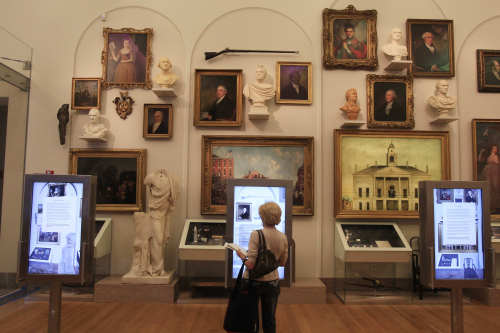NEW YORK (AP) ― New York City’s oldest museum has shed its vault-like exterior for a luminous facade that invites the public to peer in, explore its vast treasures and experience them like never before through loads of new and fun interactive features.
The New-York Historical Society threw open its doors on Friday following a $65 million, three-year renovation.
The venerable institution for the first time also has established a children’s history museum within the building and a restaurant that will stay open after hours ― all with the goal of making the museum a more open and engaging place.
The front stairs have been widened and a wall of glass, visible from the street, has been installed behind an expanded main entrance. Anyone passing by the Central Park West museum can now easily glimpse the artwork in the new 316-square-meter front gallery. And two new life-size bronze figures of Abraham Lincoln and Frederick Douglass have been planted in front.
“Now people know that history is the theme of our institution,” said Louise Mirrer, president and chief executive of the 207-year- old institution devoted to the story of New York City and how it figures into the country’s broader history.
Platt Byard Dovell White Architects led the building renovation and Lee H. Skolnick Architecture + Design Partnership was responsible for the children’s museum.
 |
Artwork is shown in the Robert H. and Clarice Smith New York Gallery of American History at the New York Historical Society museum on Nov. 8. (AP-Yonhap News) |
When the museum opened at its current site in 1907, “the outlook at the time was you had to protect your treasures from the public,” added Mirrer, explaining that the original architects were known for their design of banks.
With the reconfigured interior spaces, the museum now has 15 percent more of its collection on display.
The first thing visitors will notice is the abundance of large and small interactive and digital screens.
At the “New York Rising” installation about New York’s Federal period, visitors can rotate one of five 116-centimeter touchscreens to view computer-generated representations of the objects displayed in front of them and access layers of virtual information to add to their knowledge of the works.
Vertical flat screens, affixed to six columns in the main gallery, highlight the museum’s iconic objects, including Tiffany lamps, board games, Audubon watercolors and Hudson River School paintings.
A “living painting’’ is among the most unique _ and fun _ new features. It’s a motion-sensitive panel of “Pulling Down the Statue of King George III,’’ a 19-century painting by Johannes Adam Simon Oertel. As museum visitors walk in front of the life-size reproduction, sections of the work become animated; with the right amount of movement, the statue on the LCD panels can be “pulled down.’’ The original work is on view on the other side of the gallery.
In terms of recent collections, the museum has one of the largest collections around the events of Sept. 11, 2001, currently on display. It already has begun collecting memorabilia on Occupy Wall Street, including buttons, broadsides and various other materials produced around the grass-roots movement that’s spread throughout the country, Mirrer said.
The inaugural exhibition, “Revolution! The Atlantic World Reborn,” on the American, French and Haitian revolutions features the recently discovered and only known surviving copy of the first printing of the Haitian Declaration of Independence.
The DiMenna Children’s History Museum on the lower level was created to “give families with children a reason to come here,” said Mirrer, and is designed around a group of pavilions that portray historic figures as children.
Historic documents from the society’s collection and multilayered high- and low-tech features let young visitors explore deeper into the lives and time of such figures as Alexander Hamilton, James McCune Smith, and “Newsies,’’ the young boys and girls who hacked newspapers on the city’s streets at the turn of the 20th century.
An 18-minute, multimedia film, “New York Story,” by filmmaker Donna Lawrence is narrated by actor Liev Schreiber and projected on a 22.25-meter-wide screen in the museum’s expanded 420-seat auditorium.








